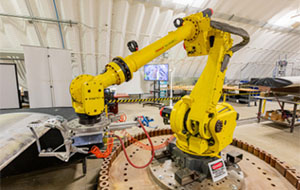Composites Manufacturing Education and Technology Facility 360 Virtual Tour (Text Version)
This is the text version of the Composites Manufacturing Education and Technology (CoMET) facility 360 virtual tour.
| Hotspot Photo | Hotspot Description |
|---|---|
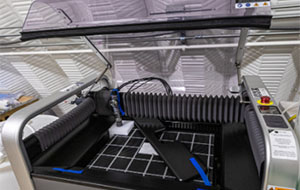 | Cuts two-dimensional shapes out of metals, composites, stone, woods, and ceramics. This allows researchers and technicians to produce components quickly and effectively for prototyping, laboratory fixtures, and research devices. Fun facts:
|
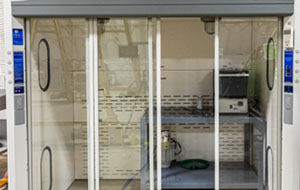 | This walk-in laboratory fume hood provides maximum visibility in the laboratory and effectively contains toxic, noxious, or other harmful materials. |
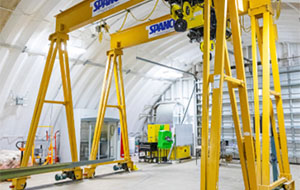 | These two 10-ton gantry cranes allow researchers to move heavy tools and equipment. The cranes are positioned on a track that runs nearly the entire length of the Composites Manufacturing Education and Technology (CoMET) facility. |
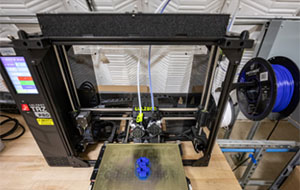 | This is a desktop-scale fused-deposition modeling/material extrusion printer that enables the low-cost printing of thermoplastic components. The printer is equipped with two extruders that allow it to make parts of different materials and colors in one print. The hardware and software for this printer are open source, allowing NLR to easily modify and upgrade the device to print novel materials that may have never been printed before. Fun facts:
|
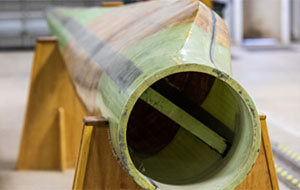 | NLR researchers used advanced composite materials to create this 9-meter recyclable thermoplastic wind turbine blade. Advanced composite materials present several potential advantages, including reduced carbon fiber costs. The first of its kind ever built in the United States, the blade is the result of a large collaboration with other national labs, academic institutions, the U.S. Department of Energy, and many industrial partners. The blade was the finalist for a Composites and Advanced Materials Expo Combined Strength Award in 2017 and for the JEC Composites World Innovation Award in 2018. Fun facts:
|
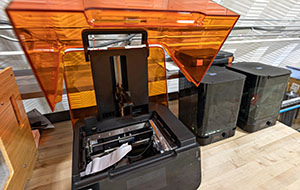 | This features a vat of photopolymer resin that cures when exposed to UV radiation. This stereolithography (SLA) style printer uses a controllable laser to selectively cure areas of resin within the vat to generate a 3D structure. The printer’s high accuracy and precision make it capable of printing very precise and smooth parts. In addition, the printer features a large assortment of photopolymer resins, which enable the printer to achieve many different materials properties. Fun facts:
|
 | This machine allows researchers and project partners to quickly turn around computerized numerically controlled (or CNC) manufactured parts out of easily machinable materials. The small scale and simple design also allow researchers to make modifications and upgrades that enable new capabilities. |
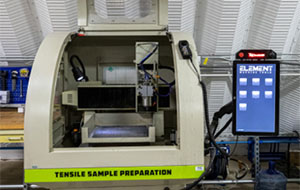 | This piece of equipment is used to make precise cuts for material characterization. |
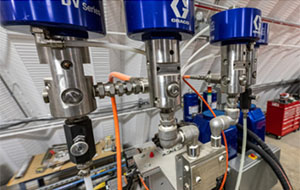 | The variable-ratio mixing (VRM) machine is used to mix epoxy resin before infusion. It can mix up to 30 kilograms of material per minute. |
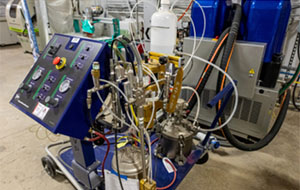 | This mixes resins such as in-place polymerized thermoplastics, polyester, and vinylester resins before infusion. |
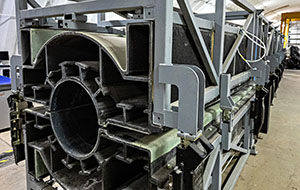 | This set of 13-meter wind blade molds is used to build 13-meter National Rotor Testbed blades. The molds were fabricated by TPI Composites with 3D printing from Oak Ridge National Laboratory and have been used to build multiple blades. NLR has validated three blades from this mold set. |
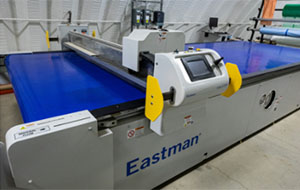 | This machine provides automated fabric cutting for composite manufacturing. It cuts dry fiberglass fabrics up to 72-inches wide, and the conveyor system enables unlimited cut lengths. The programmatic features allow custom cut shapes with excellent repeatability. |
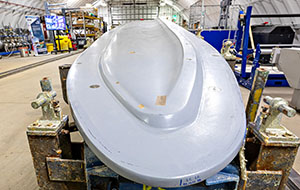 | The megawatt-scale wind blade tip mold enables manufacturing research at a scale relevant to modern commercial land-based wind turbine systems. |
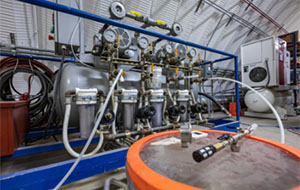 | This vacuum pump, which is an integral component of composite manufacturing, provides low pressure for closed molding systems such as vacuum assisted resin transfer molding processes (VARTM). |
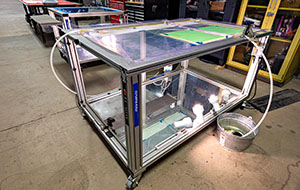 | These heated glass infusion tables are used to fabricate composite parts at scale. The glass surface provides visibility of both the top and bottom of a part during manufacturing. Internal heating elements can help with chemical curing if required. |
| This robot, which has a 125-kilogram payload and a 3,000-millimeter reach, was used primarily for research and development in advancing wind blade manufacturing technology. This platform allowed researchers to create innovative composite blade designs and develop improved manufacturing processes. Late in 2021, NLR will install a new robotic research platform, which will include a new robot (300-kilogram payload and 2,500-millimeter reach). It will be positioned on a 6-meter linear rail, which will significantly enlarge the robot’s range of motion and further expand NLR’s manufacturing and automation research capabilities within CoMET. NLR researchers are using robots to move to an automated blade finishing process. The blade finishing process involves cutting, grinding, and sanding excess material from the blade after it is removed from the mold. By using robots, researchers can automate this process that was previously only done by hand. Improved automation could increase worker safety, improve the quality of the turbine blades, and help to bring down manufacturing costs while increasing its speed and utilization factor. Fun Facts
|
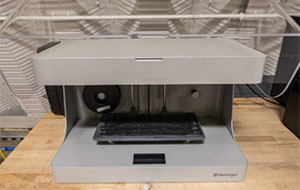 | This 3D printer is a fused-deposition modeling/material extrusion device. An additional feature of this printer is the ability to lay continuous fiber, such as carbon, glass, or Kevlar, in the thermoplastic to create composite parts. The inclusion of fiber makes parts with much higher strength than what a standard fused-deposition modeling printer can make. This capability allows for a faster design cycle and enables the creation of more complex parts than is possible with traditional manufacturing. Finally, this printer can optimize function rather than design for manufacturability. Fun facts:
|
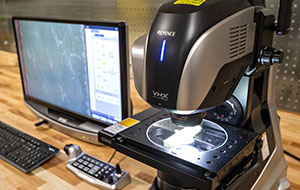 | This optical microscope is used for studying advanced manufacturing materials. |
Share
Last Updated Dec. 7, 2025

